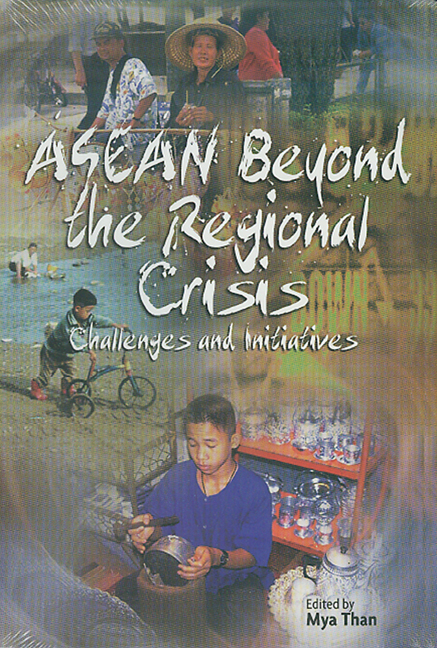Book contents
- Frontmatter
- Contents
- List of Tables
- List of Figures
- Glossary
- Contributors
- 1 ASEAN Beyond the Crisis: A Bird's-eye View
- 2 East Asia: Crisis and Recovery
- 3 Competitiveness and Sustainable Growth in ASEAN
- 4 ASEAN Free Trade Area: Progress and Challenges
- 5 ASEAN Investment Area: Progress and Challenges
- 6 Financial and Macroeconomic Co-operation in ASEAN: Issues and Policy Initiatives
- 7 Food Security in ASEAN
- 8 ASEAN Co-operation and the Environment
- 9 ASEAN and the International Trading System: Regional Trade Arrangement vs. the WTO
- 10 ASEAN and Its Inter-Regional Economic Links
- Appendix I ASEAN's Relevance: Has It Become Questionable?
- Appendix II Is ASEAN Still Relevant? Some Thoughts from a European Perspective
- Index
6 - Financial and Macroeconomic Co-operation in ASEAN: Issues and Policy Initiatives
Published online by Cambridge University Press: 03 November 2017
- Frontmatter
- Contents
- List of Tables
- List of Figures
- Glossary
- Contributors
- 1 ASEAN Beyond the Crisis: A Bird's-eye View
- 2 East Asia: Crisis and Recovery
- 3 Competitiveness and Sustainable Growth in ASEAN
- 4 ASEAN Free Trade Area: Progress and Challenges
- 5 ASEAN Investment Area: Progress and Challenges
- 6 Financial and Macroeconomic Co-operation in ASEAN: Issues and Policy Initiatives
- 7 Food Security in ASEAN
- 8 ASEAN Co-operation and the Environment
- 9 ASEAN and the International Trading System: Regional Trade Arrangement vs. the WTO
- 10 ASEAN and Its Inter-Regional Economic Links
- Appendix I ASEAN's Relevance: Has It Become Questionable?
- Appendix II Is ASEAN Still Relevant? Some Thoughts from a European Perspective
- Index
Summary
Introduction
While the intellectual debate about the exact causes of the crisis in East Asia in 1997–98 and the appropriateness of various remedies rages on, one thing is clear: the boom-bust cycle in East Asia was caused by foreign bank lending. Indeed, the major part of the net US$130 billion outflow of capital from the four crisis-hit ASEAN economies (Indonesia, Thailand, Philippines, and Malaysia) and South Korea between 1996 and 1998 was due to reversals in net short-term lending by commercial banks. Reversals in portfolio equity investments roughly averaged about US$9 billion during this period (Table 6.1). Such large-scale capital withdrawals, curtailment in lending, and consequent sharp currency devaluations inevitably created major collateral damage and dislocations to the domestic financial sectors. Indeed, the closure of troubled financial institutions was a key element of the International Monetary Fund (IMF) programmes for the crisis-hit economies (Lane and Associates 1999). Table 6.2 provides some evidence of the dominance of banks (and “near-banks”) relative to the bond and equity markets in East Asia. It is this heavy regional dependence on bank intermediation that contributed to the breadth, depth, and longevity of the crisis.
This being said, the aim of this chapter is not to revisit the origin and consequences of the crisis. Rather, the focus here is threefold. First, the issue of “regional contagion” is briefly discussed. This provides the context within which the scope — if not the type — of regional co-operation in the financial and macroeconomic spheres may be considered. Secondly, the main policy initiatives in ASEAN in these areas are highlighted. Finally, concrete policy initiatives for regional co-operation in ASEAN and the larger East Asian region are tabled.
Rationale for Regional Co-operation in the Macroeconomic and Financial Spheres
The currency crises of the 1990s, and particularly the one that hit ASEAN and the larger East Asian region in 1997–98, seem to be strongly suggestive of the relevance and pervasiveness of contagion or negative spillover effects that are largely regional in scope (thus, also referred to as “neighbourhood effects”).
Following Masson (1998), we may describe “contagion” as a situation where a currency crisis in one economy leads to a jump to a “bad” equilibrium in a “neighbouring” economy.
- Type
- Chapter
- Information
- ASEAN Beyond the Regional CrisisChallenges and Initiatives, pp. 126 - 147Publisher: ISEAS–Yusof Ishak InstitutePrint publication year: 2001



